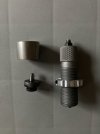You could restore the small primer pockets on the 223 Rem casings, but probably not on a .20 caliber cartridge, because the case neck ID is so small that the Grade 8 bolt small enough in diameter to fit down into your 20 cal case neck will be too small to overlap the small primer pocket diameter. And when you hammer on the bolt, it will likely punch down into the primer pocket, rather than overlap the primer pocket and be supported by solid brass in the case head surrounding the primer pocket.
I have restored .223 Rem small primer pockets by keeping the grade 8 bolt diameter as large as possible, so that it just enters the fired case necks before resizing the case neck in the resizing die. The idea is to keep the bolt diameter as large as possible so that it overlaps the primer pocket and impacts the solid brass case head surrounding the primer pocket. I think I reduced the diameter of a 1/4" diameter Grade 8 bolt for my 223 cases. I buy a bolt long enough so that I can saw off the threads and still end up with the remaining solid shank long enough to reach down into the case and bottom out around the flash hole. I cut the hex head off the bolt also.
I mounted the solid 1/4" diameter bolt in a drill press and while it was rotating in the drill press, I carefully ground down the diameter of the bolt with a 4 1/2" grinding blade, until it would just barely clear the fired case necks. I also use a dremel tool to cup the end of the bolt concave, so the end of the bolt contacts on its outer edges first, rather than on it's center. You don't want to the bolt to hit inside the diameter of the primer pocket. It needs to contact the inner case head outside the primer pocket void, where it's striking against the solid brass case head surrounding the primer pocket. I had no issues restoring primer pockets on my .223 Rem casings, in this manner. If a guy owned a lathe, he could turn down the bolts to the perfect (just clears the case neck) diameter.
Restoring 22 caliber cartridge case primer pockets is more difficult than restoring larger caliber casings. With larger caliber case necks, a larger diameter bolt can be used which helps ensure the bolt doesn't blow down into the primer pocket itself.
I shoot a 22 Creedmoor with large rifle primer pockets. There's no way to restore those primer pockets using this method, because the primer pocket is .210" in diameter, and the fired case neck ID is only .226-.229" diameter. A bolt only 0.020" larger than the primer pocket will be driven down from the inside into the primer pocket, because it's not large enough in diameter to overlap the primer pocket. A 0.010" bolt overlap of the primer pocket isn't enough overlap to support the hammer blows.
Hope this is understandable. It's much easier to restore .284, .308, and .338 cartridge primer pockets. Keep the bolt diameter as large as possible to maximize the overlap of the primer pockets. That's the trick to successful primer pocket restoration. Practice on some cheapo junk cartridge cases. Some field pickups. Then when proficient, tighten up the primer pockets on your "good" cases.

